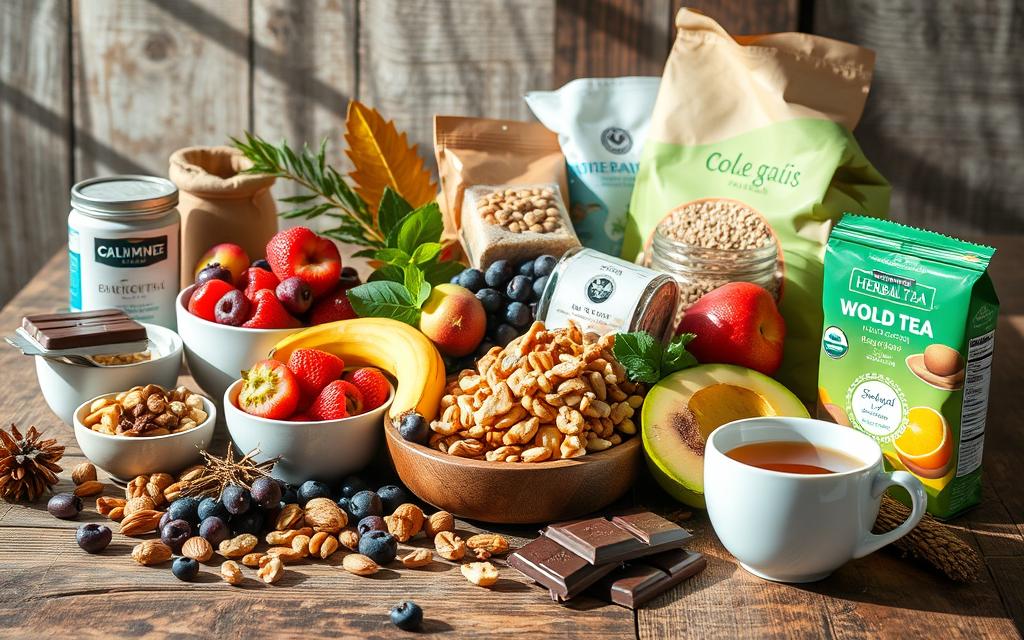Sugar cravings can feel like a tidal wave, leading to guilt and frustration. It’s easy to give in and then feel regretful. The average American eats about 57 pounds of added sugar each year, making it hard to manage1.
But we’re not alone in this fight. Many of us want to enjoy sweet treats without feeling guilty. With the right strategies, we can manage sugar cravings without feeling deprived.
Key Takeaways
- Understanding the underlying causes of sugar cravings is essential for effective management.
- Making smarter dietary choices can significantly reduce our sugar intake.
- Balanced meals play a crucial role in diminishing cravings.
- Mindfulness techniques can aid in controlling impulsive eating behaviors.
- Creating a supportive environment helps us stay committed to our dietary goals.
Understanding Sugar Cravings
It’s key to understand sugar cravings to manage them well. Almost 70% of adults say they have sugar cravings at some point2. These cravings come from both our mind and body.
We are naturally drawn to sweet tastes from birth. Sugar makes our brain happy, releasing dopamine. This can start a cycle of craving that’s hard to stop. A big dopamine boost makes us want sweet foods even more, leading to sugar cravings2. Stress also makes us want quick energy, often from sugar3.
Our body’s need for sugar can also be due to blood sugar swings. When blood sugar drops, we might want sugar for a quick energy fix. Eating a balanced diet with fiber, protein, and healthy fats can help. This can cut sugar cravings by up to 50%2.
Sleep affects our cravings too. Not sleeping enough can make us hungrier and crave sugar2. Adults should aim for 7 to 8 hours of sleep to keep hunger hormones in check2.
Understanding why we crave sugar is important. Our cravings can change based on our lifestyle. Chewing sugar-free gum can reduce cravings by about 30%2. Stress-reducing activities like meditation can also help manage cravings3.
What Causes Sugar Cravings?
Sugar cravings come from many sources, affecting our health and desire for sweets. Hormonal changes, like shifts in estrogen and progesterone, can make us crave sweets more. This is true for women, who might want sweets 10-15% more during their menstrual cycle4.
Processed foods, full of added sugars, also play a role. They cause blood sugar to spike and then drop, leading to cravings. This cycle is linked to dopamine, similar to sugar addiction54. When blood sugar drops, we often turn to sugary snacks to feel better.
Our brain chemicals, like serotonin, also affect cravings. Low serotonin can make us want more sugar, as our mood changes with our diet5. Also, not having enough minerals like magnesium, which helps control blood sugar, can make us crave sugar more. This shows that what causes sugar cravings involves both our body and mind.
Long-term sugar cravings might mean we have blood sugar issues or a busy lifestyle. Lack of sleep, for example, can lead to eating too much, often unhealthy foods5. Getting enough sleep, about eight hours a night, can help reduce cravings and improve health.
How Sugar Affects Our Bodies
Americans eat about 270 calories from added sugars every day, which is 17 teaspoons6. The American Heart Association says we should eat no more than 6 teaspoons, or 100 calories, for women and 9 teaspoons, or 150 calories, for men7. Too much sugar can cause weight gain, increase diabetes risk, and lead to heart diseases. Eating too much sugar can double the risk of heart disease compared to those who eat less than 10% of their calories from sugar6.
When we eat a lot of refined sugars, our pancreas makes more insulin. This can lead to insulin resistance, which raises the risk of type 2 diabetes6. High sugar intake also worsens joint pain and can increase the risk of rheumatoid arthritis6. Eating sugary foods often makes us crave more sugar, making it hard to stop the cycle of addiction.
Too much sugar can also cause premature aging of the skin by damaging proteins like collagen and elastin6. It can also lead to non-alcoholic fatty liver disease (NAFLD), which can get worse6.
A diet full of sugar can harm our physical and mental health, including causing depression6. Knowing the difference between natural sugars in fruits and added sugars is key to healthier eating. By choosing wisely, we can improve our health and lower the risk of chronic diseases.
| Health Impact | Sugar Source | Recommended Intake |
|---|---|---|
| Heart Disease Risk | Added Sugars | Limit to 10% of total calories |
| Joint Pain | High Sugar Intake | Stay below recommended limits |
| Skin Aging | Excess Sugar | Consume sparingly |
| Liver Health | Fructose | Less than 200 calories |
| Mental Health | High Sugar Consumption | Monitor daily intake |
Signs You May Have a Sugar Addiction
It’s important to know the signs of sugar addiction to manage our cravings better. We might find ourselves constantly wanting sugary foods, which could mean we have a problem. These cravings can get worse, making it hard to stop eating sugar, a key sign of addiction8.
When we try to eat less sugar, we might feel anxious, depressed, or tired. These feelings can last from days to weeks89.
Choosing sugary snacks over healthy ones is another sign. Our bodies might crave sugar for quick energy, causing our blood sugar to swing8. This can lead to energy highs and lows, making us want more sugar9.
Using more sugar over time can make us feel like we need even more to feel good. This can lead to serious health problems like insulin resistance and type 2 diabetes8. Knowing these signs helps us know when to ask for help with our diet.

| Signs of Sugar Addiction | Description |
|---|---|
| Frequent Cravings | Constant desire for sugary foods that may feel uncontrollable. |
| Withdrawal Symptoms | Experiencing anxiety, fatigue, or mood changes when reducing sugar intake. |
| Preference for Sugary Snacks | Choosing sweet snacks over more nutritious options. |
| Sugar Tolerance | Needing more sugar over time to achieve the same level of satisfaction. |
Healthy Alternatives to Curb Sugar Cravings
Looking for healthy snacks can help us enjoy tasty treats without harming our health. Instead of sugary foods, try fruit, nuts, or Greek yogurt. A small serving of Greek yogurt with cinnamon can make us feel full for up to 50%10
Adding high-protein foods to our meals can also help us feel full. Studies show that high-protein meals can make us feel less hungry10. A small apple with 1 tablespoon of peanut butter is a tasty, low-calorie snack that can satisfy sweet cravings11.
For a crunchy snack, try dried apricots with 12 almonds. They offer natural sweetness and healthy fats11. Chia seeds are also great for sugar cravings, as they expand in the stomach and can reduce sugar cravings by 60%12.
Hummus with raw veggies is another good choice. It’s savory and boosts our fiber intake. Fiber helps control blood sugar levels, keeping our energy stable10. By choosing these healthy options, we can stay satisfied without too much sugar.
Ways to Curb Sugar Cravings Effectively
To fight sugar cravings, we need practical steps in our daily lives. Keeping regular meal and snack times helps. It stops hunger and keeps blood sugar stable, which fights sugar cravings1314.
Starting with a protein-rich breakfast is key to avoiding mid-morning cravings. Foods high in fiber slow down sugar absorption, reducing cravings. They also make us feel full, lessening the need for sweets14.
It’s also important to tackle emotional triggers. Mindful eating helps us know when we’re eating for emotions, not hunger. On tough days, chewing gum or small treats can satisfy cravings without ruining our diet15.

Our environment affects our cravings too. Keeping sweets hidden can cut down on how much we eat15. Drinking water can also help tell thirst from hunger, a useful trick14. Having water nearby can stop us from reaching for sweets.
Using these strategies with regular exercise helps even more. It keeps blood sugar stable and manages stress hormones. This approach not only fights sugar cravings but also boosts our health, making healthy eating easier1314.
How to Stop Sugar Cravings in Their Tracks
Sugar cravings are often just temporary urges. Simple steps can help us stop sugar cravings and take back control. Walking away from temptation is a strong first move. Using distractions can also lessen the urge to give in.
Staying hydrated is also key. Drinking water helps with hunger and can reduce sugar cravings. Deep breathing, like the 4-7-8 method, can calm our minds and lessen cravings caused by stress16.
Nutritional deficiencies can make sugar cravings worse. Lack of zinc, chromium, iron, calcium, and magnesium can increase cravings17. Eating high-protein foods like Greek yogurt or eggs can help us feel full and stop cravings16.
Every step we take, like mindful eating or using sugar craving techniques, helps us manage our health. Knowing cravings are fleeting helps us build resilience. This way, we can reduce their frequency through intentional actions.
The Role of Balanced Meals in Managing Sugar Cravings
Keeping a balanced diet is key to managing sugar cravings. Each meal should have protein, healthy fats, and fiber. This mix keeps blood sugar stable and makes us feel full longer, cutting down on cravings.
Foods like yogurt and sweet potatoes are great for this. They help with meal planning and meet our nutritional needs18. Adding protein-rich foods, like eggs and lentils, also helps us feel full and less likely to crave sweets1920.
| Meal Type | Protein Source | Healthy Fats | Fiber Source |
|---|---|---|---|
| Breakfast | Scrambled Eggs | Avocado | Whole Grain Toast |
| Lunch | Grilled Chicken | Olive Oil Dressing | Quinoa Salad |
| Dinner | Baked Salmon | Walnuts | Steamed Broccoli |
| Snack | Greek Yogurt | Chia Seeds | Berries |
This table shows how balanced meals fight sugar cravings. By mixing these foods, we enjoy tasty meals and stay energized all day. Eating regularly keeps our blood sugar steady, making us less likely to grab high-sugar snacks. Let’s use these tips to make our meals healthier and our lives better.
Sugar Cravings and Emotional Eating
We often turn to sugary snacks when we’re feeling down. This shows a clear link between sugar cravings emotional triggers and emotional eating. Stress, loneliness, and boredom often lead us to unhealthy choices. For example, when things get tough, we might eat more high-calorie foods like sweets and fats, which can hurt our weight-loss plans21.
Our feelings about food can get complicated, too. Sadness or anxiety might make us eat impulsively or binge. This can lead to a cycle of guilt and sugar addiction21. Feeling unhappy with our bodies can also make us eat emotionally, for both men and women22.
To fight these cravings, we need to know what triggers them. Things like relationship problems, work stress, tiredness, and money worries can make us seek comfort in food21. Keeping a food diary can show us when and why we crave sugary snacks, helping us understand our habits21.
One good way to deal with emotional eating is to find healthier ways to cope. Activities like yoga, meditation, and deep breathing can help us handle stress better21. By paying attention to our hunger, we can tell if we’re really hungry or just eating because we’re stressed21.
Even with the tough parts of emotional eating, we can make better choices. Adding healthy snacks like fruits or veggies to our diet can help us avoid unhealthy fast food when we’re stressed22.
Mindfulness Techniques to Control Sugar Cravings
Sugar cravings are hard to manage and can hurt our weight loss goals. Many of us don’t feel calm or content after eating sugar. Instead, we often want more, not true satisfaction23. Mindfulness techniques can be very helpful in managing these cravings.
Just one minute of mindfulness can change how we react to cravings. It makes us wait longer before eating23. Our cravings are often driven by emotions like the need for connection or energy23. Guided meditation helps us understand our cravings better by focusing on our breath and feelings.
The RAIN approach—Recognize, Accept, Investigate, and Note—can help us deal with cravings24. Mindfulness practices like urge surfing help us manage cravings by focusing on our body’s sensations24. A Yale study showed mindfulness training works better than traditional treatments for cravings24.
Doing mindfulness activities, like a five-minute meditation, can reduce emotional eating23. Even short mindfulness practices can improve our health and help control sugar cravings23.

By adding mindfulness to our daily lives, we become more aware of our experiences. This leads to healthier choices and better sugar craving management24. Understanding our emotions and desires helps us make more mindful eating choices.
Using Fruit and Natural Sweeteners
Using fruit to curb cravings is a smart move for healthier eating. Fruits not only satisfy our sweet tooth but also give us important nutrients. Choosing fruits like bananas, dates, and mangoes lets us enjoy sweetness without processed sugars.
Natural sweeteners like honey and maple syrup are good when used in small amounts. They make our meals sweeter and offer more nutrients than refined sugars. Honey, for example, has antioxidants and can help fight inflammation.
It’s key to watch how much we use them to keep our diet balanced. Even natural sweeteners can add up if we use too much.
Using fruits and natural sweeteners helps us feel full and boosts our health. By choosing the right fruits and sweeteners, we can make our diet more satisfying and nutritious. This way, we cut down on processed sugars a lot.
Managing sugar cravings with these methods leads to better eating habits and lifestyle choices. It’s a wise choice for everyone25.
Creating a Supportive Environment
Managing sugar cravings starts with a supportive eating space. Organize your kitchen to highlight healthy snacks and hide sugary foods. A clean kitchen filled with fruits, nuts, and whole grains steers us towards better choices.
Getting friends and family involved is key. Share your goals to build a supportive community. Studies show this approach boosts accountability and emotional support, crucial for managing sugar cravings. Stress, which increases ghrelin and lowers serotonin, makes us crave unhealthy foods26. A supportive environment helps fight these cravings.
Also, make your dining area inviting. Aim for a well-lit, comfy space that encourages mindful eating. This setup helps us focus on our meals and aids digestion, key for managing cravings. Using whole foods on your table reminds you of your goals and helps cut down on added sugar, which we consume too much of in the U.S27..

In short, shaping our surroundings and sharing our goals with loved ones creates a supportive eating space. This environment not only reduces sugar cravings but also supports our health goals. By making positive changes, we set a positive tone for our choices and behaviors.
Tips on Meal Planning to Avoid Sugar Cravings
Planning meals can really help us avoid sugar cravings. By organizing our meals and snacks, we avoid quick, sugary foods. Eating regularly helps keep our blood sugar stable, which stops cravings28. This way, we make better food choices and stay on track with healthy eating.
Making a shopping list is key. A good list helps us avoid buying foods full of added sugars. Americans eat about 17 teaspoons of added sugar daily28. Cooking meals in bulk helps us avoid unhealthy snacks.
Tracking our sugar cravings helps us understand our eating habits. Experts say planning meals can stop diet problems, as unplanned eating leads to cravings29.
Stress can also make us crave sugar. Using different strategies can help us manage these cravings28. By focusing on healthy eating and listening to our bodies, we can avoid sugar cravings.
| Meal Planning Tips | Benefits |
|---|---|
| Prepare Weekly Menus | Helps maintain balanced meals and reduces impulse eating. |
| Create a Grocery List | Reduces deviations towards unhealthy food options. |
| Batch Cook Meals | Provides quick healthy options and saves time. |
| Track Sugar Cravings | Improves awareness of eating habits and triggers. |
| Use a Variety of Strategies | Enhances chances of successfully managing cravings. |
Important Lifestyle Changes to Reduce Sugar Cravings
Making big changes in our lifestyle can help us fight sugar cravings. Regular exercise is key because it lowers hunger hormones. Drinking enough water also helps manage blood sugar, which reduces cravings.
Getting enough sleep is also important. Lack of sleep can make us crave more sugar. So, getting a good night’s rest is crucial for our health.
It’s important to understand our eating habits. Skipping meals can make us eat too much later, leading to sugar cravings. Eating at regular times helps us make better food choices and control hunger.
Our sugar intake matters too. The average American eats too much sugar, more than the recommended amount. Eating more fiber, about 35 grams a day, helps regulate blood sugar better30.
Keeping a food diary can help us track sugar intake. It shows us when we snack too much. Cutting down on sugar for a few weeks can help our brains get used to less sugar30.

To support our efforts, we should avoid cutting out whole food groups. This can lead to nutritional problems. Using mindful eating, like only having dessert on special occasions, can help us stay on track.
Conclusion
Managing sugar cravings is key for our health and happiness. Knowing what triggers our desire for sweets helps us find better ways to deal with cravings. The average American eats about 156 pounds of sugar each year. Choosing better snacks and eating more fiber can really help cut down on cravings31.
Also, staying active and getting enough sleep helps us fight sugar cravings. This approach keeps our blood sugar stable and lessens the need for sugary foods31. By eating well, we avoid serious health problems like diabetes32.
By using these strategies every day, we can manage sugar cravings for good. It’s about finding a balance that works for us, not feeling like we’re missing out. Making smart food choices and watching our sugar intake leads to a healthier life32.
FAQ
What are sugar cravings, and why do we experience them?
Sugar cravings are strong urges to eat sweet foods. They happen for many reasons, like how our brains react to sugar. This reaction makes us want more sweet foods.
How can we effectively manage our sugar cravings?
To manage cravings, try healthy foods and plan meals well. Include protein, fats, and fiber. Mindfulness and meal planning also help keep blood sugar steady and cravings down.
What causes sugar cravings?
Many things can cause cravings, like hormonal changes, low blood sugar, and stress. Lack of sleep and not getting enough nutrients also play a part. Foods with lots of added sugar can make cravings worse by changing blood sugar levels fast.
How does sugar affect our health?
Too much sugar can harm our health. It can lead to obesity, heart disease, and diabetes. It makes our body produce more insulin, which can make us want more sugar, creating a bad cycle.
What are the signs of sugar addiction?
Signs of addiction include strong cravings and trouble controlling sugar intake. You might feel sick without it or prefer sugary snacks over healthy ones.
What healthy alternatives can we use to curb sugar cravings?
For a sweet fix, try fruits, nuts, or yogurt. You can also have a little of your favorite sweet treats with healthier foods. This way, you don’t have to give up everything you love.
What immediate techniques can we use to stop sugar cravings?
To stop cravings fast, walk away from sweets, drink water, or do some quick exercise. Remember, cravings are usually short-lived urges.
How do balanced meals impact sugar cravings?
Meals with protein, fats, and fiber keep blood sugar stable. This makes you feel full longer and reduces cravings for sugar.
How can emotional eating contribute to sugar cravings?
Eating due to emotions, like stress, can lead to sugar cravings. It’s important to find better ways to handle feelings instead of turning to sweets.
How can mindfulness techniques help us control sugar cravings?
Mindfulness, like meditation and journaling, helps you notice cravings and what triggers them. It helps you make better food choices.
What role do fruits and natural sweeteners play in satisfying cravings?
Fruits and natural sweeteners like honey offer healthier sweet options. They give us nutrients while satisfying our sweet tooth. Just remember to eat them in moderation.
How can we create a supportive environment for healthier eating?
Make your kitchen healthier by showing off healthy snacks and hiding sugary ones. Share your goals with friends and family to get their support.
What tips can we follow for effective meal planning to avoid cravings?
Plan meals ahead by prepping and batch cooking. Keep a list of what you need and stick to it. This way, you’ll always have healthy food ready and avoid sugary temptations.
What lifestyle changes can help reduce sugar cravings?
Changes like more exercise, enough sleep, and staying hydrated can cut down cravings. These habits also boost your overall health.
